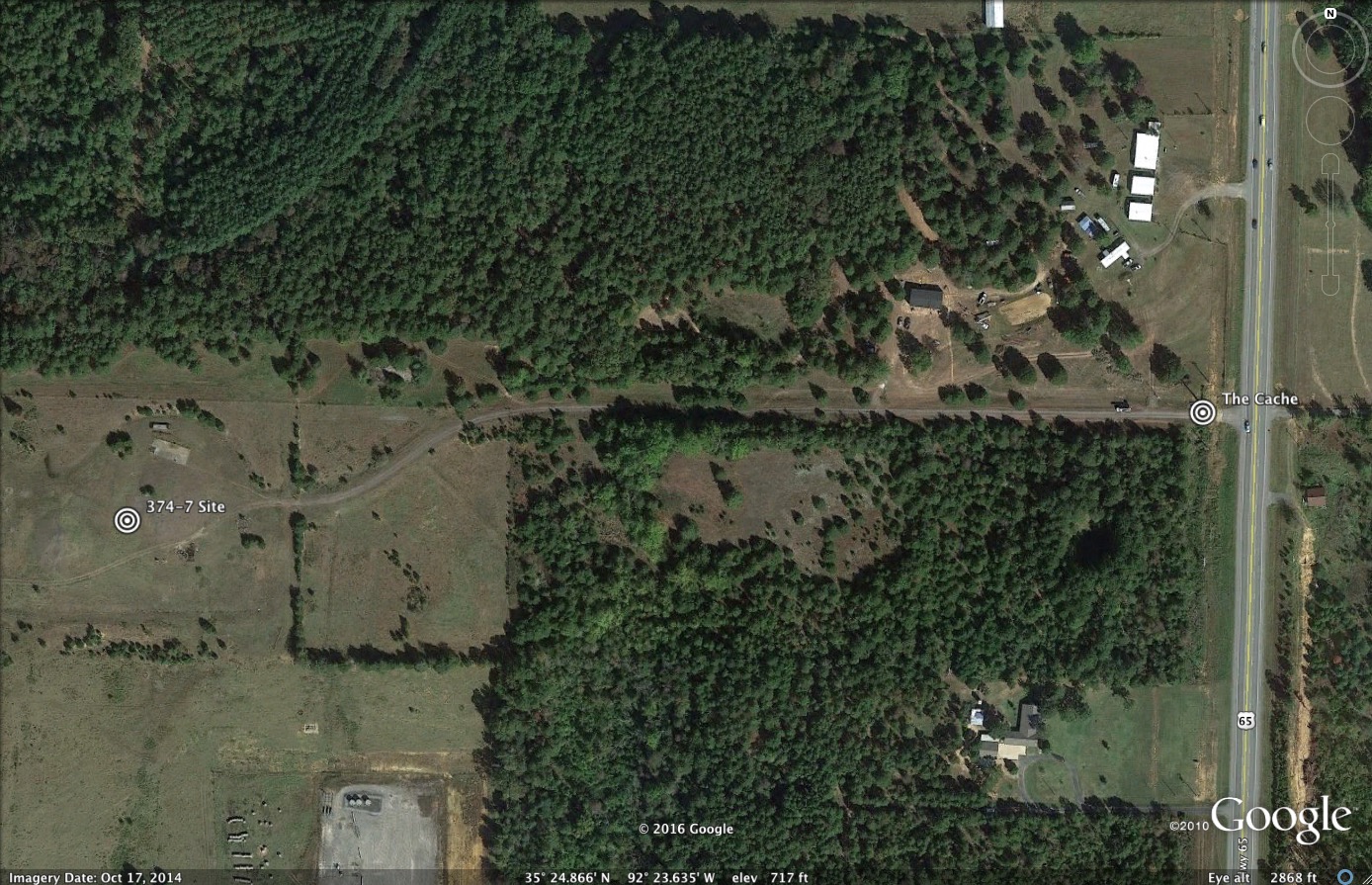The Arkansas Titan II Missile Silo (TMS) Series
Dedicated to those who served with the 308th Strategic Missile Wing.

This cache should be an easy find, as it has not been placed to challenge your geocaching skills, but rather to bring you to a place of historical interest.
Background
During the Cold War era, Arkansas was on the forefront of our Nation’s offense and defense as it was home to 18 Titan II intercontinental ballistic missile (ICBM) silos. The silos were under the command of the 308th Strategic Missile Wing (SMW) at Little Rock Air Force Base (LRAFB), with the 373rd and 374th Strategic Missile Squadrons (SMSs) responsible for nine missiles each.
Each silo was actually part of a missile launch complex which consisted of the silo connected directly to an underground launch control capsule. The launch control capsule was manned continuously by a missile combat crew of two officers and two airmen.
On the surface, the Titan II launch facilities covered an area of approximately 600 feet by 600 feet. All of the launch facilities were underground. The silo was built of heavily reinforced concrete, and was 147 feet deep and 55 feet in diameter. The silo was covered with a steel and concrete door that weighed 740 tons and could be opened in 17 to 20 seconds.
The silo was connected to the missile launch control center by a 250-foot long access tunnel. The launch control center was a dome-shaped reinforced concrete structure 37 feet in diameter and containing three levels. The control center provided space for all of the launch control and communications equipment, as well as a mess and sleeping quarters for the 4-person combat crew.
Each Titan II missile was capable of being launched within one minute and could reach its target 5,500 miles away in 30 to 35 minutes. Each Titan II missile carried a 9-megaton nuclear warhead. For comparison, this warhead was approximately 600 times more powerful than the first atomic bomb dropped on Hiroshima during World War II.
On September 24, 1981, the Reagan administration announced plans to retire the Titan II program, citing concerns about safety, a need for cost efficiency, and an evolving nuclear strategy focusing on more modern and precise weapons systems. All of the Arkansas missile silos were destroyed during the late 1980’s and the 308th SMW was formally deactivated on August 18, 1987, ending more than twenty-five years of service.
The History of This Location
Welcome to Titan II Missile Silo Site 374-7, located near the community of Southside. It was one of the nine missile silos operated by the 374th SMS, which was active from September 1st 1962 until August 15th 1986. Key milestones for this specific site were:
- Construction started: January 30, 1961
- Construction completed: December 27, 1962
- Site placed on alert (activated): December 18, 1963
- Site taken off alert (deactivated prematurely): September 21, 1980
This site is probably the most famous of all the missile silo sites in Arkansas due to an accident which occurred here in 1980. On September 19, 1980 during routine maintenance in the silo, an Air Force repairman dropped a heavy wrench socket, which rolled off a work platform and fell toward the bottom of the silo. The socket bounced and struck the missile, causing a leak from a pressurized fuel tank. The missile complex and the surrounding area were evacuated and a team of specialists was called in from LRAFB.
About 8 1/2 hours after initial puncture, fuel vapors within the silo ignited and exploded, destroying the launch complex. The explosion fatally injured one member of the team. Twenty-one other USAF personnel were injured. The missile's reentry vehicle, which contained a 9-megaton nuclear warhead, was recovered intact. There was no radioactive contamination. According to the Center for Defense Information(CDI): The explosion of volatile fuel blew off the 740 ton silo door of reinforced concrete and steel and catapulted the warhead 600 feet.
In early October 1980, cleanup operations gathered tons of debris from around 400 acres surrounding the launch complex and pumped some 100,000 gallons of contaminated water from the silo. The total cost to replace Launch Complex 374-7 was estimated at $225,322,670, while demolition and cleanup were expected to cost $20,000,000. Ultimately, the Air Force decided to seal the complex with soil, gravel, and small concrete debris.
This site was placed on the National Register of Historic Places in 2003, one of three of the Arkansas missile sites to be on this list. According to the documentation submitted with the application for placement on the register, the three-level launch control center is still intact, although the equipment has been removed. The access portal is partially filled with rubble, however, and the blast lock doors are tack-welded shut, so entry into the old facility is not possible.
When you arrive at the posted coordinates, you will be standing on the old roadway to the actual missile site, which is located is approximately 0.4 mile west of you and is located on private land. (See photo below.)
The Cache
You will be searching for a magnetic key box (as of 02/22/22; the original cache container was a baby soda bottle, aka preform). You do not have to cross any fences or gates to find the cache. Please replace it exactly as you found it so that it remains hidden from muggles and so that other geocachers may have as much fun as you in finding the cache!

Don't forget to get the clue for the bonus cache GC74PJR!
|